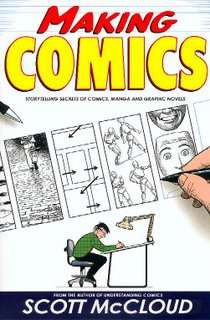 I hope that everybody who's interested in animation has read Scott McCloud's book Understanding Comics. While it's obviously not about animation, it is about visual storytelling. McCloud is excellent at taking things apart and seeing how they work. When reading Understanding Comics, I found myself always relating his insights to animation.
I hope that everybody who's interested in animation has read Scott McCloud's book Understanding Comics. While it's obviously not about animation, it is about visual storytelling. McCloud is excellent at taking things apart and seeing how they work. When reading Understanding Comics, I found myself always relating his insights to animation.McCloud has a new book out called Making Comics. Like the earlier volume, the book is in comics form and is just as valuable for animation people. There are things within the book that can be applied to script writing, design, storyboarding and animation posing. Furthermore, he has an interesting theory on artists falling into four basic categories. I first read McCloud on this subject in The Education of a Comics Artist edited by Michael Dooley and Steven Heller. Here, McCloud deals with the categories in visual terms.
McCloud's categories are classicists, animists, formalists and iconoclasts. The classicists are those artists who embrace craft and beauty. The animists are the storytellers, more concerned with content than displays of virtuosity. The formalists are concerned with the nature of the medium they're working in and the iconoclasts are interested in honesty and authenticity.
The lines between these categories are not hard and fast, but you may find yourself mostly in one category. Personally, I'm an animist. I've always cared about content, which is the root of my frustration with the animation business.
Looking at better-known people in animation, I'd put early Disney and Bluth in the classicist category, Miyazaki in the animist category, Norman McLaren in the formalist category and early Ralph Bakshi in the iconoclast category.
McCloud also talks about clarity coming from six choices: moment (in film terms, what story elements to include in a scene), frame (composition), image (character and set design), word (dialogue) and flow (camera movement and cutting).
Other chapters deal with facial expressions and body language, the relationship of words and pictures, world building, drawing tools, manga's visual communication strategy, and the nature of being a comics professional.
There's a lot to chew on here. You can learn from McCloud just by seeing how he uses visuals to put his ideas across. If you're looking to shake up your own approach to animation, I guarantee you that this book will force you to think hard about it whether you agree with McCloud or not.
I agree Mark. I read Understanding Comics on the train back from the San Diego Comicon. It moved me to write one of the few fan letters I ever wrote to a fellow cartoonist. Once you skim his discussion of page boxes and dialogue balloons, a lot is relevant to animation.
ReplyDeleteI especially found his analysis of Japanese Manga enlightening.